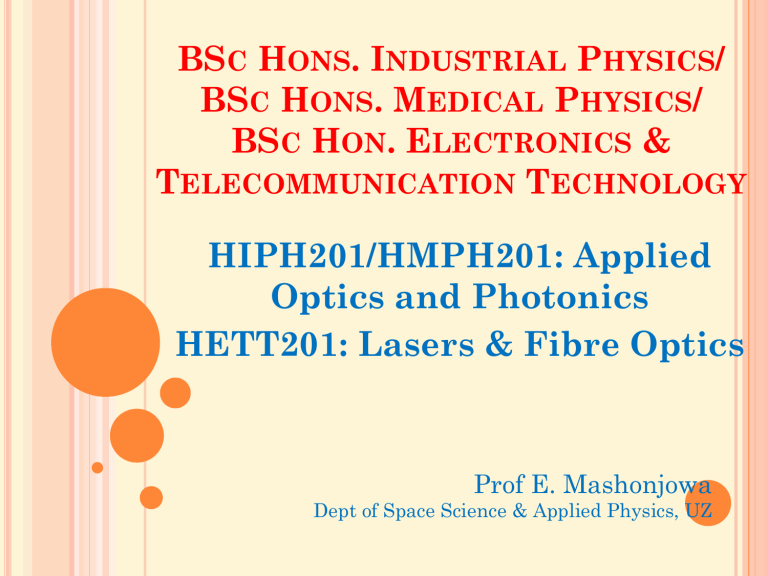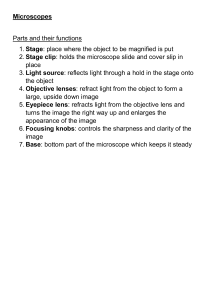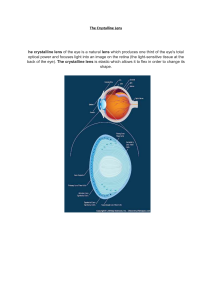
BSC HONS. INDUSTRIAL PHYSICS/ BSC HONS. MEDICAL PHYSICS/ BSC HON. ELECTRONICS & TELECOMMUNICATION TECHNOLOGY HIPH201/HMPH201: Applied Optics and Photonics HETT201: Lasers & Fibre Optics Prof E. Mashonjowa Dept of Space Science & Applied Physics, UZ LECTURE 7: OPTICAL DEVICES AND SYSTEMS Optical Instruments Optical Instruments • Analysis generally involves the laws of reflection and refraction: realm of Geometric optics • To explain certain phenomena, the wave nature of light must be used The Camera • Is an optical instrument • Components: – Opaque, light-tight box – Converging lens • Produces a real image Object O – CCD (or Film) behind the lens • Receives the image digital analog I Real Inverted M<0 I smaller than O |M | < 1 Digital Camera • Image is formed on an electric device CCD: Charge-Coupled Device CMOS: Complementary Metal-Oxide Semiconductor • Both convert the image into digital form • The image can be stored in the camera’s memory Camera Operation • Proper focusing leads to sharp images The lens-to-film distance q depends on: the object distance p and on the focal length • The shutter is a mechanical device that is opened for selected time intervals f of the lens • Most cameras have an aperture of adjustable diameter D to control the intensity of the light reaching the film Small-diameter aperture: only light from the central portion reaches the film => spherical aberration is minimized Camera Operation, Intensity • Light intensity: the rate at which energy is received by the film per unit area • The intensity is proportional to the area of the lens, ~ D2 • The brightness of the image formed on the film depends on the light intensity – Depends on both the focal length f ~1/f and the diameter of the lens D: Intensity 2 Camera, f-numbers • The ƒ-number of a camera is the ratio of the focal length of the lens to its diameter f:D f ƒ-number = f/D The ƒ-number is given a description of the lens “speed” • A lens with a low f-number is a “fast” lens Can take pictures in low-light conditions QQz: this lens, fast or slow? Camera, f-numbers, Cont. • The lowest ƒ-number setting: the aperture wide open, the maximum possible lens area in use • Simple “point-and-shoot” cameras: a fixed focal length and a fixed aperture size, with an ƒ-number of about 11 The high value of ƒ allows for a large depth-of-field => no need to focus the camera => no good pictures in low-light conditions The Eye • The normal eye focuses light and produces a sharp image • Essential parts of the eye: Cornea – light passes through this transparent structure Aqueous Humor – clear liquid behind the cornea • The pupil A variable aperture An opening in the iris • The crystalline lens Most of the refraction takes place at the outer surface of the eye, where the cornea is covered with a film of tears The Eyes – Parts, Cont. • The iris is the colored portion of the eye – It is a muscular diaphragm that controls pupil size – Regulates the amount of light entering the eye by dilating the pupil in low-light conditions and contracting the pupil in high-light conditions – The f-number of the eye is from about 2.8 to 16 The Eye – Operation • The cornea-lens system focuses light onto the back surface of the eye, called the retina – The retina contains receptors of two types, rods and cones – These structures send impulses via the optic nerve to the brain The brain converts these impulses into our conscious view of the world Conditions of the Eye • A mismatch between the focusing power of the lens-cornea system and the length of the eye, d d • Eyes may be Nearsighted Light rays reach the retina after they converge to form an image Farsighted Light rays reach the retina before they converge to form an image Farsightedness Light rays reach the retina before they converge to form an image • Also called hyperopia • The image focuses behind the retina • Can usually see far away objects clearly, but not nearby objects Correcting Farsightedness • A converging lens placed in front of the eye can correct the condition • The lens refracts the incoming rays more toward the principle axis before entering the eye – This allows the rays to converge and focus on the retina Nearsightedness Light rays reach the retina after they converge to form an image • Also called myopia • In axial myopia: the lens is too far from the retina • In refractive myopia: the lens-cornea system is too powerful Correcting Nearsightedness • A diverging lens can be used to correct the condition. • The lens refracts the rays away from the principle axis before they enter the eye – This allows the rays to focus on the retina. Simple Magnifier • A simple magnifier consists of a single converging lens This device • … is used to increase the apparent size of an object • The size of an image formed on the retina depends on the angle subtended by the eye The Size of a Magnified Image • When an object is placed at the near point, the angle subtended is θo – The near point is about • When the object is placed near the focal point of a converging lens, the lens forms a virtual, upright, and enlarged image h’ Compound Microscope • A compound microscope consists of two lenses – Gives greater magnification than a single lens – The objective lens has a short focal length, ƒo< 1 cm – The ocular lens (eyepiece) has a focal length, ƒe, of a few cm Compound Microscope, Cont. • The lenses are separated by a distance L L >> ƒo , ƒe is much greater than either focal length • The approach to analysis is the same as for any two lenses in a row: – The image formed by the first lens becomes the object for the second lens • The image seen by the eye, I2, is virtual, inverted and very much enlarged Magnifications of the Compound Microscope • The lateral magnification of the microscope is • The angular magnification of the eyepiece of the microscope is • The overall magnification of the microscope is the product of the individual magnifications Other Considerations with a Microscope • The ability of an optical microscope to view an object depends on the size of the object, d, relative to the wavelength λ of the light used to observe it. – Example, you could not observe an atom with visible light: d 0.1 nm λ 500 nm Electronatomic-forcetunnelingmicroscopy Telescopes • Two fundamental types of telescopes – Refracting telescope uses a combination of lenses – Reflecting telescope uses a curved mirror and a lens In both types, two optical elements in a row: the image of the first element becomes the object of the second element Refracting Telescope • The objective forms a real, inverted image I1 • The image is near the focal point of the eyepiece Fe • The two lenses are separated by the distance ƒo + ƒe about the length of the tube • The eyepiece forms an enlarged, inverted image I1 of the distant object Angular Magnification of a Telescope • The angular magnification depends on the focal lengths of the objective and eyepiece: • Angular magnification is only important for observing nearby objects • Very distant objects such as stars still appear as small points of light • Main goal of astronomy telescopes: Collect Light! Disadvantages of Refracting Telescopes • Large diameters are needed More Light! to study distant objects • Large lenses are difficult and expensive to manufacture • The weight of large lenses leads to sagging which produces aberrations Reflecting Telescope • Helps overcome some of the disadvantages of refracting telescopes – Replaces the objective lens with a mirror – The mirror is often parabolic to overcome spherical aberrations • In addition, the light never passes through glass (except a small eyepiece) – Reduced chromatic aberrations Reflecting Telescope, Newtonian Focus • The incoming rays are reflected from the mirror and converge toward point A – At A, a photographic plate or other detector can be placed • A small flat mirror, M, reflects the light toward an opening in the side and passes into an eyepiece Examples of Telescopes • Reflecting Telescopes Largest in the world are D= 10 m Keck telescopes on Mauna Kea in Hawaii altitude 4145 m • Refracting Telescopes Largest in the world is Yerkes Observatory in Wisconsin • Has a 1 m diameter The Hubble Space Telescope • D = 2.4-meter observe in the near-UV, visible, and near-IR spectra • Enables us to see deep into space • And further back in time! Its scientific successor is scheduled to be launched in 2018 The RadioAstron, “biggest-ever” telescope • a Russian orbital D = 10-meter parabolic • Collecting data on clouds of water molecules found in the discs of galaxies Application of Photonics -Optical Communication • Telecommunications Communications over “long distances” • Information is encoded as signals • Signals are transmitted through a medium • Signals are directed to recipients • Many technologies – Electronic, radio, microwave – Fiber-optic, atmospheric optical What is communicated? • Data – Telegrams – Computer data, telemetry, etc. – Internet , files, web pages • • • • Voice: telephone, radio Video: sound and images All are encoded as signals Systems are converging Signal Structure • Signal modulates a carrier wave – Carrier wave is at much higher frequency • Amplitude modulation changes carrier intensity – Standard in fiber optics, AM radio • Frequency modulation changes carrier frequency – Standard for FM radio, television Modulation formats Signal Format and Structure (1) Signal Format and Structure (2) Bandwidth • Information per unit time – Frequency in Hertz (cycles per second) – Bits per second • Depends on signal source and format – HDTV is highest video, analog NTSC lower – Stereo music more than telephone audio • Capacity depends on transmission medium • May vary with length of medium Multiplexing • • • • • • • • Combines two or more signals Multiple signals sent over one path Dates back to telegraph Reduces costs Type Frequency-division Time-division Wavelength-division Frequency-division multiplexing Time-division multiplexing Wavelength-division multiplexing Transmission distance • Key figure of merit • Depends on – Transmitter power – Receiver sensitivity – Attenuation • May vary with signal bandwidth – Copper attenuation increases with frequency Networks & Connectivity • Network distributes signals • Types of connectivity – Point to point – Point to multipoint (broadcast) – Switched – Networked Fiber-optic communication • is a method of transmitting information from one place to another by sending light through an optical fiber. • The light forms an electromagnetic carrier wave that is modulated to carry information. Fiber-optic communication • The process of communicating using fiberoptics involves the following basic steps: – Creating the optical signal using a transmitter, – relaying the signal along the fiber, ensuring that the signal does not become too distorted or weak, and – receiving the optical signal and converting it into an electrical signal. How does fiber optic transmit light? Optical Fiber: Advantages • Capacity: much wider bandwidth (10 GHz) • Crosstalk immunity • Immunity to static interference – Lightning – Electric motor – Florescent light • Higher environment immunity – Weather, temperature, etc. Optical Fiber: Advantages • Safety: Fiber is non-metalic – No explosion, no chock • Longer lasting • Security: tapping is difficult • Economics: Fewer repeaters – Low transmission loss (dB/km) – Fewer repeaters Remember: Fiber is non– Less cable conductive Hence, change of magnetic field has No impact! Optical Fiber: Disadvantages • • • • • • Higher initial cost in installation Interfacing cost Strength Lower tensile strength Remote electric power More expensive to repair/maintain Tools: Specialized and sophisticated Copper vs fiber bandwidth Optical fiber communication: Architecture Optical Fiber Architecture – Components Global network Components of global network • Submarine cables – High capacity intercontinental – Shorter, regional cables • • • • National backbone networks Regional networks Local networks Satellites play minor role Network nodes • Network nodes Present in long-haul, regional and metro • Hubs or terminal points – Ends of cables where signals are switched and reorganization – Signals typically regenerated – Signals may be broken down to slower data rates or multiplexed to higher rates • Add/drops – Only a few optical channels are added/dropped Optical Communication Systems Fibre Structure Types of optical fibre Dispersion Absorption Losses in Optic Fibre Fibre Alignment Impairments Optical Fibre System





